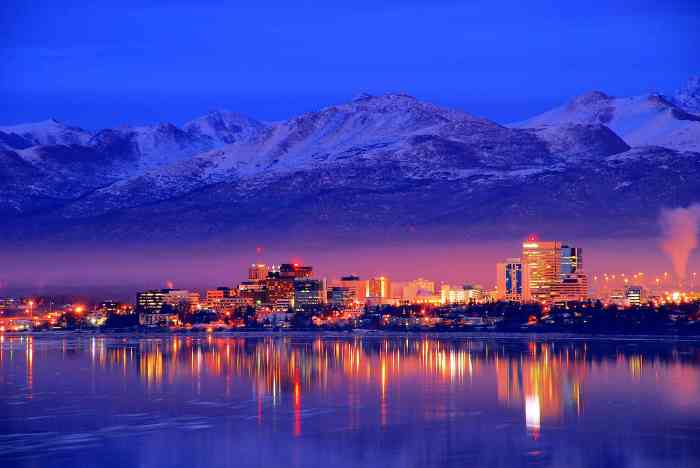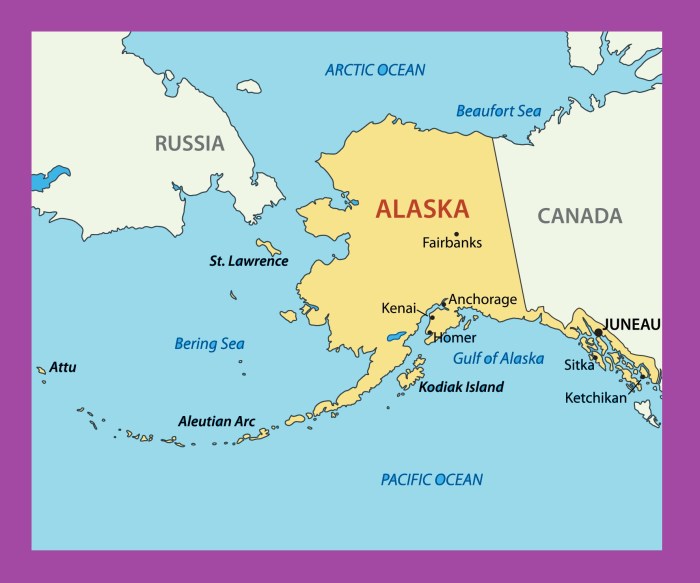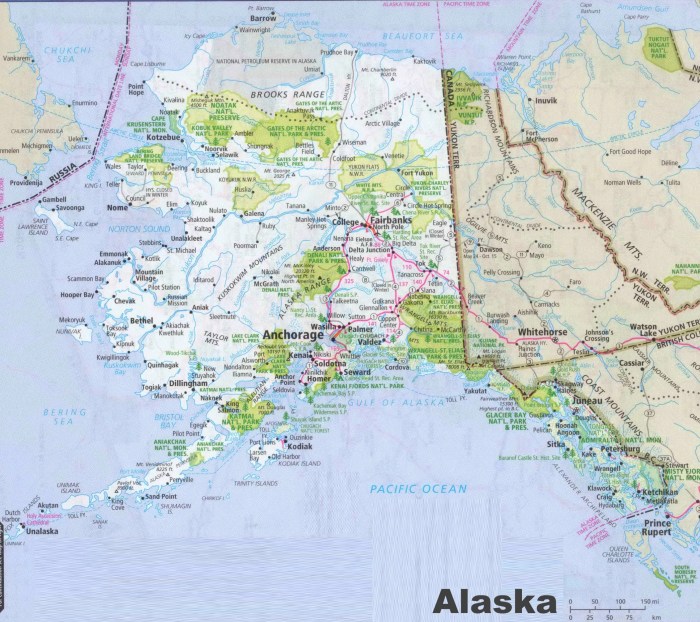Embark on an extraordinary journey to AlaskaUSA, a land of breathtaking beauty, rich cultural heritage, and thrilling adventures. From the towering peaks of Denali to the pristine waters of Glacier Bay, Alaska’s natural landscapes captivate the imagination. Immerse yourself in the vibrant cultures of indigenous communities, discovering their traditions, languages, and art forms. Prepare to embark on unforgettable adventures, hiking through pristine wilderness, kayaking amidst towering glaciers, and witnessing the majestic wildlife that roams this untamed frontier.
AlaskaUSA’s diverse ecosystems support a remarkable array of flora and fauna, including iconic species such as grizzly bears, bald eagles, and whales. The state’s economy is driven by key industries such as oil and gas, tourism, and renewable energy, offering ample opportunities for investment and economic growth. Alaska’s unique climate patterns and environmental challenges present both opportunities and challenges, highlighting the importance of protecting and preserving its natural resources.
Alaska’s Natural Wonders
Alaska is renowned for its breathtaking natural beauty, encompassing diverse landscapes that inspire awe and wonder. From towering mountains to pristine glaciers, the state’s natural wonders offer an unparalleled experience for visitors and locals alike.
One of Alaska’s most iconic landmarks is Denali National Park and Preserve. Home to the majestic Mount Denali, the highest peak in North America, the park boasts a vast wilderness teeming with wildlife, including grizzly bears, moose, and wolves. Visitors can explore the park’s rugged terrain through hiking, backpacking, and wildlife viewing.
Another natural treasure of Alaska is Glacier Bay National Park and Preserve. This vast wilderness area features stunning glaciers, towering mountains, and abundant marine life. Visitors can cruise through the park’s icy waters, marveling at the massive glaciers and spotting whales, seals, and sea otters.
Flora and Fauna
Alaska’s diverse ecosystems support a rich variety of flora and fauna. The state’s northern regions are home to the Arctic tundra, a treeless plain covered in mosses, lichens, and wildflowers. The interior of Alaska is dominated by boreal forests, characterized by spruce, fir, and birch trees. The coastal regions feature temperate rainforests, home to towering Sitka spruce and Western hemlock trees.
If you’re planning a beach holiday in Alaska, you’ll need to pack for all types of weather. The weather in Alaska can be unpredictable, so it’s important to pack layers of clothing so you can adjust to the changing temperatures.
You’ll also want to pack a beach holiday packing list with items like sunscreen, sunglasses, and a hat. And don’t forget to pack a swimsuit, because there are plenty of beautiful beaches in Alaska to enjoy.
Alaska’s wildlife is equally diverse. The state is home to a large population of brown bears, as well as black bears, polar bears, and grizzly bears. Other notable wildlife species include moose, caribou, wolves, and a variety of marine mammals, such as whales, seals, and sea lions.
Alaska’s Indigenous Cultures

Alaska is home to a diverse array of indigenous cultures, each with its unique traditions, languages, and art forms. These cultures have thrived in the region for thousands of years, adapting to the challenges and opportunities presented by the harsh Arctic environment.
The indigenous peoples of Alaska have a deep connection to the land and its resources. They have developed sustainable practices for hunting, fishing, and gathering that have allowed them to live in harmony with the environment. Their traditional knowledge and skills have been passed down through generations and continue to play a vital role in their communities today.
Alaska’s Adventure Activities
Alaska, a vast and untamed wilderness, beckons adventure seekers with its unparalleled natural beauty and thrilling outdoor pursuits. From hiking through pristine trails to kayaking amidst towering icebergs, Alaska offers an adrenaline-pumping playground for every taste and skill level.
Before embarking on your adventure, ensure your safety by researching tour operators with proven experience and a strong reputation. Check their safety protocols, equipment quality, and guide qualifications. Be prepared for unpredictable weather conditions by packing appropriate clothing and gear, including layers, rain gear, and sturdy footwear.
Hiking
Alaska’s vast wilderness offers countless hiking trails, ranging from gentle strolls to challenging ascents. Explore the iconic Denali National Park and Preserve, home to North America’s highest peak, Mount Denali. Trek through the lush Tongass National Forest, renowned for its towering trees and pristine lakes. Discover hidden waterfalls and alpine meadows in the Kenai Fjords National Park.
Kayaking
Glide through the tranquil waters of Alaska’s pristine coastline or venture into the icy depths of its fjords. Kayak amidst towering glaciers, spot marine wildlife such as whales, sea otters, and seals, and explore hidden coves and inlets inaccessible by land.
Fishing
Cast your line in Alaska’s abundant rivers, lakes, and coastal waters. Whether you’re an experienced angler or a novice, you’ll find a fishing adventure tailored to your skill level. Go salmon fishing in the Kenai River, renowned for its prolific runs. Try your luck at halibut fishing in the Gulf of Alaska, known for its giant flatfish. Or embark on a deep-sea fishing charter to catch halibut, cod, and other species.
Alaska is a captivating destination that offers an array of activities for families on a budget. Consider budget family vacations that include wildlife viewing, glacier trekking, and kayaking. These experiences provide a memorable and affordable way to explore the breathtaking landscapes of Alaska.
Wildlife Viewing
Alaska is a wildlife paradise, home to a diverse array of animals in their natural habitats. Embark on a wildlife viewing tour to spot grizzly bears, moose, caribou, and wolves. Observe whales, sea lions, and puffins from the comfort of a boat or kayak. Visit national parks and wildlife refuges to see these magnificent creatures in their natural environment.
Alaska’s Economic Opportunities

Alaska’s economy is largely influenced by natural resources, tourism, and the military. The state has abundant oil and gas reserves, which account for a significant portion of its revenue. The tourism industry is also a major contributor to the economy, with visitors drawn to Alaska’s natural beauty, wildlife, and outdoor recreation opportunities. The military also has a significant presence in Alaska, with bases located throughout the state.
Oil and Gas
The oil and gas industry is the largest economic driver in Alaska. The state has vast reserves of both oil and natural gas, and the production and sale of these resources generate a substantial amount of revenue for the state government. The industry also provides thousands of jobs for Alaskans.
Tourism
Tourism is the second-largest industry in Alaska. The state’s natural beauty, wildlife, and outdoor recreation opportunities attract millions of visitors each year. Tourism generates revenue for businesses throughout the state, including hotels, restaurants, tour operators, and retailers.
Renewable Energy
Alaska has significant potential for renewable energy development. The state has abundant wind, solar, and hydro resources, and it is increasingly investing in renewable energy projects. Renewable energy development could help Alaska reduce its reliance on fossil fuels and create new jobs.
Emerging Economic Sectors
In addition to the traditional economic drivers, Alaska is also exploring new economic opportunities. These include:
- Mariculture: Alaska has a long coastline and abundant marine resources, which could be used to develop a sustainable mariculture industry.
- Mining: Alaska has significant mineral resources, including gold, silver, copper, and zinc. The mining industry could provide new jobs and economic opportunities for Alaskans.
- Technology: Alaska is home to a growing technology sector. The state has a number of universities and research institutions that are developing new technologies and products.
Alaska’s Climate and Environment

Alaska’s vast and diverse landscape is shaped by its unique climate patterns. The state experiences extreme temperature variations, with long, cold winters and short, mild summers. Precipitation levels vary widely across the state, with coastal areas receiving significantly more rainfall than inland regions.
The climate of Alaska is influenced by several factors, including its high latitude, proximity to the Pacific Ocean, and the presence of mountain ranges. The state’s high latitude means that it receives less direct sunlight than lower latitudes, resulting in colder temperatures. The Pacific Ocean moderates temperatures along the coast, while the mountain ranges create rain shadows that reduce precipitation in inland areas.
Climate Change in Alaska
Alaska is experiencing the effects of climate change more rapidly than any other U.S. state. The average temperature in Alaska has increased by about 3 degrees Fahrenheit over the past century, and the rate of warming is accelerating. Climate change is causing glaciers to melt, sea levels to rise, and permafrost to thaw. These changes are having a significant impact on Alaska’s environment and economy.
The melting of glaciers and sea ice is reducing the amount of habitat available for marine life. Rising sea levels are threatening coastal communities and infrastructure. Thawing permafrost is causing the ground to become unstable, which can damage buildings and roads.
AlaskaUSA, the leading credit union in Alaska, provides exceptional financial services to its members. For those traveling to Abu Dhabi, it’s essential to stay updated on the abu dhabi time difference. By understanding the time zone variations, you can plan your itinerary effectively and avoid any potential scheduling conflicts.
AlaskaUSA offers convenient online banking and mobile app access, allowing you to manage your finances from anywhere, including while exploring the vibrant city of Abu Dhabi.
Protecting Alaska’s Natural Resources, Alaskausa
Alaska’s natural resources are a vital part of the state’s economy and way of life. The state is home to vast forests, fisheries, and mineral deposits. Alaska also has some of the most pristine wilderness areas in the United States.
There are a number of efforts underway to protect and preserve Alaska’s natural resources. The state has established a system of parks and protected areas to safeguard its wildlife and wilderness. The state also regulates the development of natural resources to minimize the impact on the environment.
In addition to state efforts, there are a number of non-profit organizations working to protect Alaska’s environment. These organizations work to educate the public about environmental issues, advocate for policies that protect the environment, and conduct research on the effects of climate change.
Alaska’s Historical Significance

Alaska’s rich history has shaped its present-day identity, leaving a legacy of diverse cultures, industries, and landscapes.
The timeline below highlights key historical events that have influenced Alaska’s development:
- 1741: Russian explorer Vitus Bering discovers Alaska.
- 1799: Russian-American Company established, marking the beginning of Russian colonization.
- 1867: United States purchases Alaska from Russia for $7.2 million.
- 1896: Gold Rush begins, bringing thousands of prospectors to Alaska.
- 1912: Alaska becomes a territory of the United States.
- 1959: Alaska achieves statehood, becoming the 49th state.
Russian Colonization
Russian colonization began in the late 18th century and lasted for over a century. The Russians established trading posts, fur trapping operations, and Orthodox Christian missions throughout Alaska.
Their presence had a significant impact on Alaska’s indigenous population, introducing new diseases and cultural practices. The Russian Orthodox Church remains a prominent religious institution in Alaska today.
The Gold Rush
The discovery of gold in the Klondike region in 1896 triggered a massive influx of prospectors and settlers to Alaska. The Gold Rush brought economic prosperity to the territory, but it also led to environmental degradation and social unrest.
The legacy of the Gold Rush can still be seen in the ghost towns and mining camps scattered throughout Alaska.
Alaska’s Path to Statehood
Alaska’s journey to statehood was a long and complex process. The territory was initially governed by the United States military, followed by a period of civilian rule. In 1912, Alaska became a territory, gaining greater autonomy.
The movement for statehood gained momentum in the mid-20th century, and Alaska finally achieved statehood in 1959. As a state, Alaska has greater control over its natural resources and economic development.
Epilogue

AlaskaUSA stands as a testament to the power of nature, the resilience of indigenous cultures, and the spirit of adventure. Its breathtaking landscapes, vibrant communities, and thrilling experiences beckon travelers and adventurers alike. As we delve into the depths of this extraordinary region, we uncover a world of wonders that will forever captivate our hearts and minds.
FAQ Corner: Alaskausa
What is the best time to visit Alaska?
The best time to visit Alaska depends on your interests. For wildlife viewing, summer (June-August) is ideal. For hiking and camping, late spring (May-June) and early fall (September-October) offer pleasant weather. For aurora viewing, winter (December-March) provides the best conditions.
How do I get around Alaska?
Alaska is vast, and the best way to get around depends on your itinerary. Flying is the fastest option, but it can be expensive. Driving is a good choice if you have plenty of time and want to explore at your own pace. There are also train and ferry services available.
What are the must-see attractions in Alaska?
Alaska offers a wealth of must-see attractions, including Denali National Park, Glacier Bay National Park, Kenai Fjords National Park, and the Inside Passage. Other popular destinations include Anchorage, Fairbanks, and Juneau.
What are the safety precautions I should take when visiting Alaska?
Alaska is generally a safe place to visit, but there are some precautions you should take. Be aware of wildlife, especially bears. Carry bear spray and store food properly. Be prepared for changing weather conditions and bring appropriate clothing. Respect the environment and follow all park regulations.